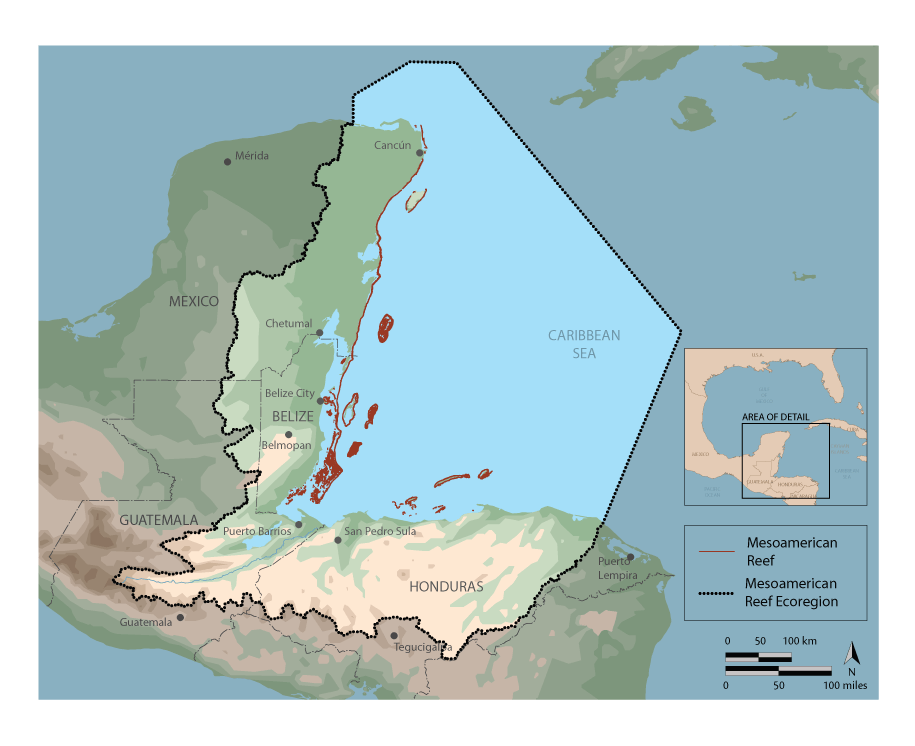The Mesoamerican Barrier Reef System: Exploring the Enchanting Underwater Ecosystem
The Mesoamerican Barrier Reef System, or the Great Mayan Reef, is a beautiful and ecologically significant wonder in the Caribbean Sea. It is the largest barrier reef in the Western Hemisphere, spanning from Isla Contoy to Belize, Guatemala, and the Bay Islands of Honduras.
The Mesoamerican Barrier Reef System
Exploring the Enchanting Underwater Ecosystem
Nestled within the turquoise embrace of the Caribbean Sea lies a natural wonder of unparalleled beauty and ecological significance – the Mesoamerican Barrier Reef System (MBRS), often called the Great Mayan Reef. This marine jewel stands as the most extensive barrier reef system in the Western Hemisphere, stretching over 1,000 kilometers (625 miles) from Isla Contoy at the tip of the Yucatán Peninsula south to Belize, Guatemala, and the Bay Islands of Honduras.
Geographical and Ecological Overview
The Mesoamerican Barrier Reef System is not merely a collection of coral formations but a sprawling marine, underwater ecosystem and geological structure that serves as a vital ecological cornerstone. Its extensive reach encompasses diverse habitats, stretching from the northeastern corner of Honduras to the shores of Nicaragua. Along this vast expanse, dazzling arrays of coral species form a mesmerizing underwater wilderness, providing homes and sustenance to a myriad of marine life.
Protected Areas and Parks
Within the MBRS, several protected areas and parks have been established to safeguard its fragile ecosystems. These include renowned sites like the Belize Barrier Reef, Arrecifes de Cozumel National Park, Hol Chan Marine Reserve in Belize, the Sian Ka'an Biosphere Reserve, and the Cayos Cochinos Marine Park. Belize, in particular, boasts the distinction of housing approximately 80% of the Mesoamerican Barrier Reef, with the Belize Barrier Reef being the largest barrier reef in the northern hemisphere and the second-largest globally. This remarkable natural treasure has earned UNESCO World Heritage Site status, emphasizing its global importance.
Biodiversity and Marine Life
The Mesoamerican Barrier Reef System is a biodiversity hotspot, hosting a staggering array of marine species. Over 65 species of stony coral, 350 species of mollusk, and more than 500 species of fish call this reef system home. Endangered and protected species, including sea turtles (green, loggerhead, leatherback, and hawksbill), the queen conch, West Indian manatee, splendid toadfish, American and Morelet's crocodiles, Nassau grouper, elkhorn coral, and black coral, find sanctuary within the protected confines of the reef.
Unique Residents and Marine Giants
Its unique residents and occasional visitors distinguish the Mesoamerican Barrier Reef System. It is home to one of the world's largest populations of manatees, reflecting the reef's crucial role in supporting diverse marine life. In the northern areas near Isla Contoy, the largest fish on the planet, the majestic whale shark, graces the reef with its presence, adding an awe-inspiring dimension to the underwater spectacle.
Conservation Significance
Mangroves along the shores play a vital role in the health of the Mesoamerican Barrier Reef System. They provide habitat for fish and shorebirds and act as a natural shield, protecting coastal areas from the destructive forces of hurricanes and intense storms. The delicate balance of this ecosystem is a testament to the need for vigilant conservation efforts to ensure the continued existence of this natural masterpiece.
Conclusion
The Mesoamerican Barrier Reef System unfolds as a masterpiece of nature, a thriving underwater realm where biodiversity flourishes and marine life finds refuge. Every facet of this reef system contributes to its global significance, from its protected parks to the diverse array of coral and marine species. As we marvel at the wonders of the Mesoamerican Barrier Reef, it becomes imperative to recognize its vulnerability and actively participate in its conservation, ensuring that this extraordinary underwater haven remains a beacon of ecological resilience for generations.

Location map of the Mesoamerican Reef System.
